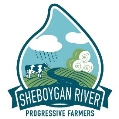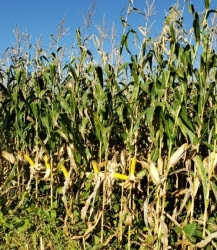
Farming the same area of land for over 130 years, Mark Loehr and his family know how important it is to keep the soil healthy.
In 2017, Loehr was approached by another local farmer, Craig Goeser, to help create a group where neighbors could share ideas about conservation practices. Together with a few others, they created Sheboygan River Progressive Farmers (SRPF).
Mark and his brother Joe jointly own Loehr Dairy in eastern Fond du Lac County, where they milk 500 cows and grow crops on about 1,000 acres. Loehr initially integrated a conservation practice of planting rye after corn silage harvest because the farm wanted to grow more feed for the heifers. Over time and with the help of SRPF, Loehr has introduced new practices and found many benefits that are protecting not only his family but the whole watershed community when it comes to water and soil.
 |
as a double crop to build soil health and create more diversity in the animal feed.
“This group allows us to share different ideas and experiences. It connects us to other farmers. When it’s time to make decisions on practices, we have a bank of knowledge from other members to draw from,” Loehr said. “If there is something you’re thinking about trying, you can learn from the network.”
In 2017, Loehr started experimenting with a new practice — intercropping corn silage and soybeans. He knew that anytime you try something new, it’s a learning experience and doesn’t always work perfectly. In this trial, the farm learned the importance of spacing the corn and soybeans and incorporated drilling the soybeans in between 30-inch rows of corn. Corn is the main crop, while soybeans are secondary. Not only did Loehr increase feed and help his soil, he also found unanticipated benefits.
“We realized rather quickly that having beans between the corn allowed us to travel through the fields with more root mass much easier,” he said. “2018 and 2019 were very wet years, and we could tell the acres where we had the two crops together were less messy. We made fewer ruts and harvesting was much easier ― that’s why you try something new.”
SRPF’s 31 members represent 23,100 acres and approximately 12,150 dairy cows and beef cattle. The group collaborates with university researchers, environmental groups and community leaders to promote and implement innovative farming practices.
In 2021, members planted 7,288 acres of cover crops and 15,100 acres using strip-tillage and no-tillage. In all, conservation practices increased by 13% from the previous year. From 2018 to 2021, the use of cover crops increased by 150%, and four times the amount of acres were no-tillage. Some farmers incorporate multiple practices on the same fields.
All that work significantly reduces the chance of harmful runoff into streams and lakes.
The farmers last year potentially prevented an estimated 25,415 pounds of phosphorus from leaving the fields, decreased sediment erosion by 8,900 tons and reduced CO2 equivalents by 8,185 tons, according to an analysis shared by the state Department of Agriculture, Trade and Consumer Protection (DATCP), the University of Wisconsin-Madison and The Nature Conservancy (TNC). For comparison, a mid-size dump truck can carry 10 tons of sediment. One pound of phosphorus in a lake or stream has the potential to cause the growth of up to 500 pounds of algae, which can degrade water quality. The tons of CO2 reduction by SRPF members equal the greenhouse gas emissions from 1,764 cars driven for a year.
The modeling-based analysis calculated an estimate of the potential impact of cover crops, strip-tillage and no-tillage compared to more conventional methods typical to SRPF’s area.
Loehr is impressed with increases in the adoption of conservation practices.
“We have young families, and we feel it’s very important to provide our community with the healthiest foods that they can get. By implementing these practices, we feel we are protecting not only our family but the whole watershed,” Loehr said.
As the director of agriculture strategies for TNC, Steve Richter works closely with SRPF to introduce new ideas and provide support. He sees how farmers are learning from each other and gaining confidence across the watershed by staying connected.
“There is a great interest among the SRPF farmers in practices that improve soil health and increase productivity, and these farmers are making these practices more accessible to others by sharing lessons learned,” Richter said.

